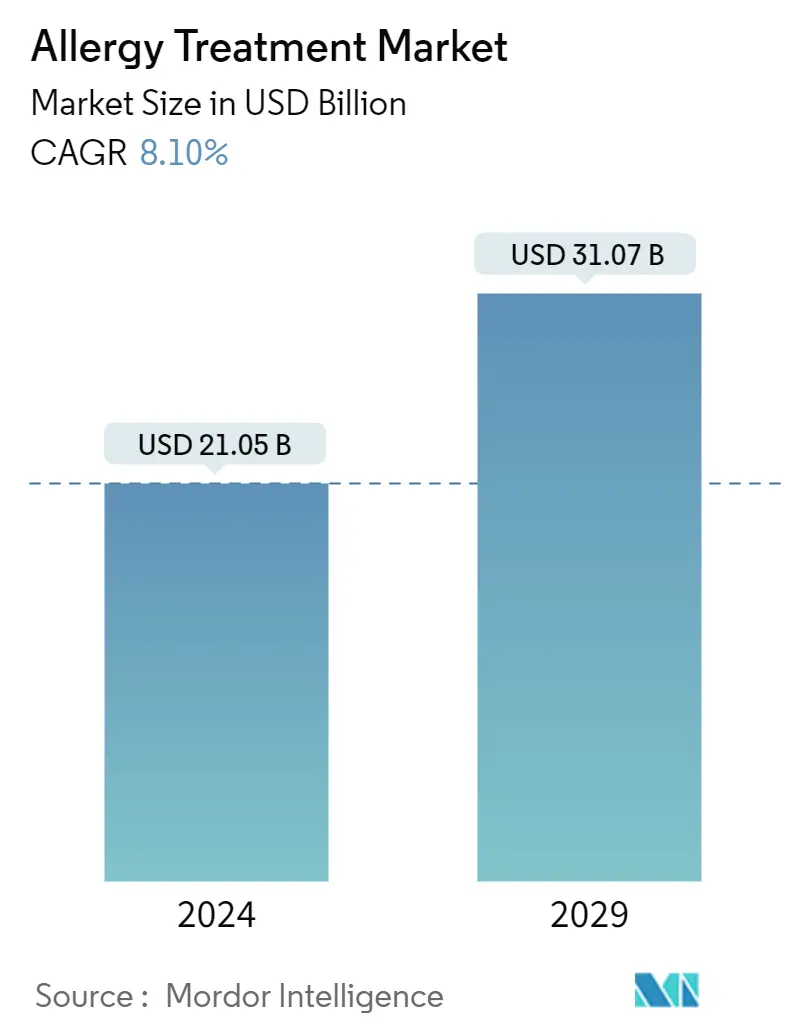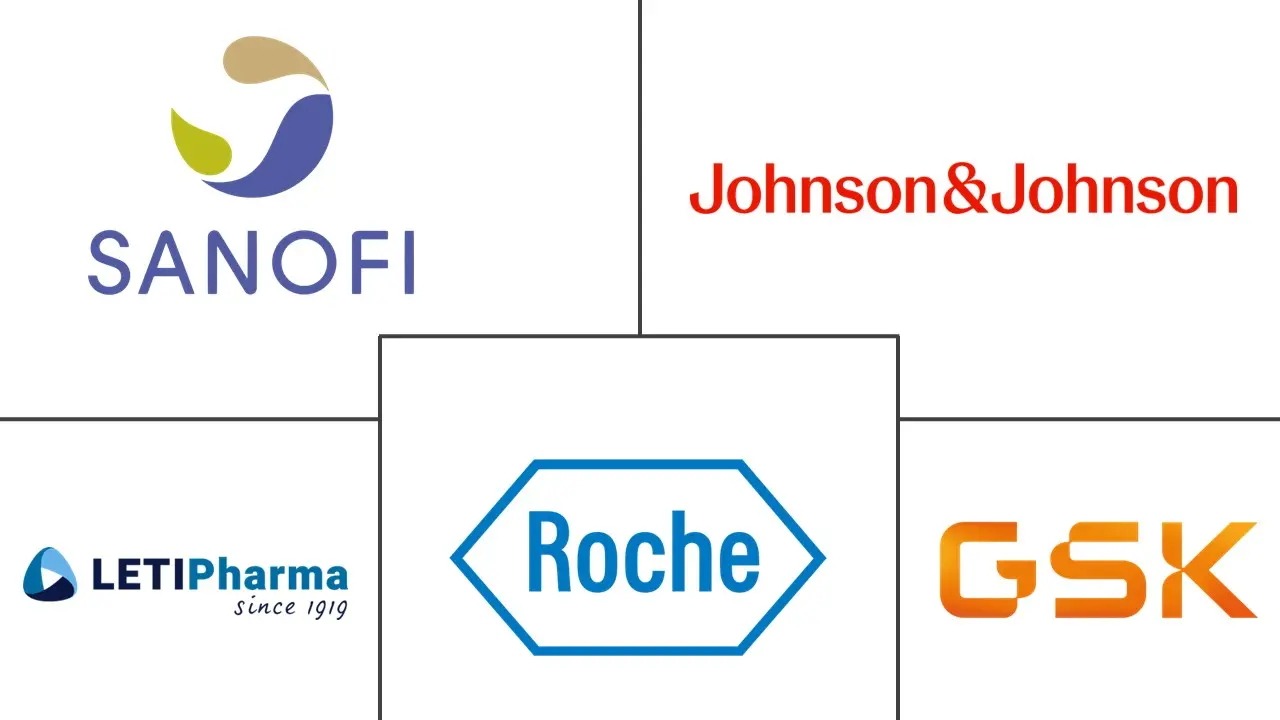Market Size of Allergy Treatment Industry

| Study Period | 2024 - 2029 |
| Market Size (2024) | USD 21.05 Billion |
| Market Size (2029) | USD 31.07 Billion |
| CAGR (2024 - 2029) | 8.10 % |
| Fastest Growing Market | Asia Pacific |
| Largest Market | North America |
| Market Concentration | Low |
Major Players
*Disclaimer: Major Players sorted in no particular order |
Allergy Treatment Market Analysis
The Allergy Treatment Market size is estimated at USD 21.05 billion in 2024, and is expected to reach USD 31.07 billion by 2029, growing at a CAGR of 8.10% during the forecast period (2024-2029).
The increasing prevalence of various kinds of allergies, the rising investment in the development of novel allergic therapies, and the growing importance of self-medication are the major factors accelerating the market's growth. Allergies occur due to the hypersensitivity of the immune system to foreign substances. Allergic conditions are one of the most common health issues affecting the population in the United States. For instance, in 2023, the Asthma and Allergy Foundation of America (AAFA) reported that more than 100 million Americans are affected by various types of allergies yearly. According to the same report, about 26% of adults and 19% of children in the United States were diagnosed with seasonal allergic rhinitis, highlighting the significant size of the Seasonal Allergic Rhinitis Market.
Furthermore, according to the study published in the National Library of Medicine in October 2023, across continents, the values of asthma prevalence ranged from 3.44%, 3.67%, 4.90%, 5.69%, 8.29%, and 8.33% in Asia, Africa, South Africa, Europe, North America, and Oceania, respectively. Thus, the growing prevalence of allergies is expected to increase demand for their treatment, thereby boosting the growth of the Asthma Allergy Treatment Market.
With the increase in allergic reactions, there are rising investments worldwide to develop novel treatments, further expanding the Drug Allergy Treatments and Drugs Market. For instance, in October 2023, Aiolos Bio, a newly launched startup with an asthma drug in clinical trials, announced that it raised USD 245 million in Series A funding. Aiolos plans to use the funds for phase II clinical trials of its lead drug candidate, AIO-001, for moderate-to-severe asthma patients. In addition, in January 2024, GSK initiated a deal to acquire Aiolos Bio for USD 1.4 billion to access the development of Aiolos' phase II-ready AIO-001 asthma treatment.
Furthermore, in January 2024, Aravax, a startup firm, raised USD 66 million in a funding round to develop a novel peanut allergy treatment, contributing to the growth of the Peanut Allergy Treatment Market. Aravax is a clinical-stage biotechnology company focused on revolutionizing food allergy treatment through its product, PVX108. Hence, such huge investments are expected to drive the market studied over the forecast period.
However, the growing preference for low-cost biosimilars and lack of awareness regarding Allergy Immunotherapy can hamper the market's growth.
Allergy Treatment Industry Segmentation
Allergy is a condition in which the immune system reacts abnormally to a foreign substance. Allergy treatment involves drugs and therapies that reduce the symptoms of allergies and help the immune system prepare for future encounters.
The allergy treatment market is segmented by type, treatment, and geography. By type, the market is segmented into eye allergy, rhinitis, asthma, skin allergy, and other allergies. By treatment, the market is segmented into anti-allergy drugs and immunotherapy. By geography, the market is segmented into North America, Europe, Asia-Pacific, Middle East and Africa, and South America). The market report also covers the estimated market sizes and trends for 17 countries across major regions globally. The report offers market size and forecast in terms of value (USD) for the above segments.
| By Type | |
| Eye Allergy | |
| Rhinitis | |
| Asthma | |
| Skin Allergy | |
| Food Allergies | |
| Other Allergies |
| By Treatment | ||||||
| ||||||
|
| Geography | ||||||||
| ||||||||
| ||||||||
| ||||||||
| ||||||||
|
Allergy Treatment Market Size Summary
The allergy treatment market is poised for significant growth, driven by the increasing prevalence of allergies and the rising investment in novel therapeutic developments. The market is characterized by a surge in allergic conditions, which are among the most common health issues globally, particularly in the United States. This growing demand for effective treatments is further fueled by the importance of self-medication and advancements in immunotherapy options, such as subcutaneous immunotherapy (SCIT). SCIT offers a promising approach for managing allergic conditions, providing long-term relief and potentially curing diseases rather than merely alleviating symptoms. The market is also witnessing substantial investments, with startups like Aiolos Bio and Aravax securing significant funding to develop innovative treatments for asthma and peanut allergies, respectively. These developments are expected to propel the market forward over the forecast period.
North America is anticipated to maintain a significant share of the allergy treatment market, driven by the high prevalence of allergies and asthma, along with increased research activities and strategic product launches. The region's market growth is supported by government initiatives and the introduction of new immunotherapy products, such as ADP101 and PALFORZIA, which have received regulatory approvals. The market landscape is fragmented, with key global players like Johnson & Johnson, Sanofi, and GlaxoSmithKline leading the charge in research and development. These companies are leveraging their resources to enhance distribution systems and expand their market presence. Despite challenges such as the preference for low-cost biosimilars and limited awareness of allergy immunotherapy, the market is expected to grow steadily, driven by the ongoing innovation and strategic initiatives in the allergy treatment sector.
Allergy Treatment Market Size - Table of Contents
-
1. MARKET DYNAMICS
-
1.1 Market Overview
-
1.2 Market Drivers
-
1.2.1 The Increasing Importance for Self-medication
-
1.2.2 Rising Incidence of Food Allergies Worldwide
-
1.2.3 Rising Investments by Manufacturers in the Development of Novel Allergic Treatments
-
-
1.3 Market Restraints
-
1.3.1 Rise in Preference Toward the Use of Biosimilars
-
1.3.2 Low Awareness of Allergy Immunotherapy (AIT) Among Patients
-
-
1.4 Porter's Five Forces Analysis
-
1.4.1 Threat of New Entrants
-
1.4.2 Bargaining Power of Buyers/Consumers
-
1.4.3 Bargaining Power of Suppliers
-
1.4.4 Threat of Substitute Products
-
1.4.5 Intensity of Competitive Rivalry
-
-
-
2. MARKET SEGMENTATION (Market Size by Value - USD)
-
2.1 By Type
-
2.1.1 Eye Allergy
-
2.1.2 Rhinitis
-
2.1.3 Asthma
-
2.1.4 Skin Allergy
-
2.1.5 Food Allergies
-
2.1.6 Other Allergies
-
-
2.2 By Treatment
-
2.2.1 Anti-Allergy Drugs
-
2.2.1.1 Antihistamines
-
2.2.1.2 Corticosteroids
-
2.2.1.3 Decongestants
-
2.2.1.4 Other Drugs
-
-
2.2.2 Immunotherapy
-
2.2.2.1 Sub-cutaneous Immunotherapy (SCIT)
-
2.2.2.2 Sub-lingual Immunotherapy (SLIT)
-
-
-
2.3 Geography
-
2.3.1 North America
-
2.3.1.1 United States
-
2.3.1.2 Canada
-
2.3.1.3 Mexico
-
-
2.3.2 Europe
-
2.3.2.1 Germany
-
2.3.2.2 United Kingdom
-
2.3.2.3 France
-
2.3.2.4 Italy
-
2.3.2.5 Spain
-
2.3.2.6 Rest of Europe
-
-
2.3.3 Asia-Pacific
-
2.3.3.1 China
-
2.3.3.2 Japan
-
2.3.3.3 India
-
2.3.3.4 Australia
-
2.3.3.5 South Korea
-
2.3.3.6 Rest of Asia-Pacific
-
-
2.3.4 Middle East and Africa
-
2.3.4.1 GCC
-
2.3.4.2 South Africa
-
2.3.4.3 Rest of Middle East and Africa
-
-
2.3.5 South America
-
2.3.5.1 Brazil
-
2.3.5.2 Argentina
-
2.3.5.3 Rest of South America
-
-
-
Allergy Treatment Market Size FAQs
How big is the Allergy Treatment Market?
The Allergy Treatment Market size is expected to reach USD 21.05 billion in 2024 and grow at a CAGR of 8.10% to reach USD 31.07 billion by 2029.
What is the current Allergy Treatment Market size?
In 2024, the Allergy Treatment Market size is expected to reach USD 21.05 billion.

